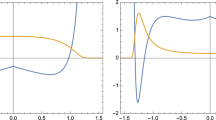Abstract
A new approach based on Darboux transformations is introduced to generate classes of solvable Schrödinger equations for new anharmonic potentials with variable bumps and depths. By introducing the concept of a transformation key, we present a method of controlling the number of bumps and their depths in these potentials. Although this method was applied to the one-dimensional generalized harmonic oscillator potential, it can be easily adapted to generate exactly solvable potentials using other known quantum potentials.








Similar content being viewed by others
Notes
For \(n=3,\,5,\,7,\,9,\,\ldots \), the sequence that is generated \(-48a^{3} \,,\, 960 a^{4} -20160 a^{5} 483840 a^{6} -13305600 a^{7},\cdots \) deserves its own study.
References
G. Darboux, Lecons sur la theorie generale des surfaces et les application geometriques du calcul infinitesimal Deuziem pattie (Gauthier-Viltars et fils, Paris, 1889)
T.E. Infeld, H. Hull, The factorization method. Rev. Mod. Phys. 53, 21 (1951)
S.-H. Dong, Factorization Method in Quantum Mechanics (Springer, Kluwer Academic Publisher, Berlin, 2007)
W.-C. Qiang, S.-H. Dong, SUSYQM and SWKB approaches to the relativistic equations with Hyperbolic potential \(V_0 \tanh ^{2} (r/d)\). Phys. Scr. 72, 127 (2005)
E. Witten, Dynamical breaking of supersymmetry. Nucl. Phys. B 188, 513 (1981)
A. Anderson, R. Camporesi, Intertwining operators for solving differential equations, with applications to symmetric spaces. Commun. Math. Phys. 130, 61–82 (1990)
F. Cooper, A. Khare, U. Sukhatme, Supersymmetry in Quantum Mechanics (World Scientific, Singapore, 2002)
V.G. Bagrov, B.F. Samsonov, Darboux transformation, factorization, and supersymmetry in one-dimensional quantum mechanics. Theor. Math. Phys. 104, 1051 (1995)
A.A. Suzko, A. Schulze-Halberg, Darboux transformations and supersymetry for the generalized Schrödinger equations in \((1+1)\) dimensions. J. Phys. A Math. Theor. (2009). https://doi.org/10.1088/1751-8113/42/29/295203
A.A. Suzko, E. Velicheva, Supersymmetry and darboux transformations. J. Phys. Conf. Ser. (2012). https://doi.org/10.1088/1742-6596/343/1/012120
K.R. Bryenton, Darboux-Crum Transformations, Supersymmetric Quantum Mechanics, and the Eigenvalue Problem, (B.Sc Hons) University of Prince Edward Island, Charlottetown, Canada (2016). https://doi.org/10.13140/RG.2.2.23129.98408
V.B. Matveev, M.A. Salle, Darboux Transformations and Solitons (Springer, Berlin, 1991)
A. Arsenault, S. Opps, N. Saad, Solvable potentials with exceptional orthogonal polynomials. Ann. Phys. (Berlin) (2015). https://doi.org/10.1002/andp.201500255
I.I. Gol’dman, D.V. Krivchenkov, Problems in Quantum Mechanics (Pergamon, London, 1961)
R.L. Hall, N. Saad, A.B. von Keviczky, Matrix elements for a generalized spiked harmonic oscillator. J. Math. Phys. 39, 6345 (1998)
R.L. Hall, N. Saad, A.B. von Keviczky, Generalized spiked harmonic oscillator. J. Phys. A Math. Gen. 34, 1169 (2001)
D. Agboola, J. Links, I. Marquette, Y.-Z. Zhang, New quasi-exactly-solvable class of generalized isotonic oscillators. J. Phys. A Math. Theor. 47, 395305 (2014)
J.F. Cariñena, A.M. Perelomov, M.F. Rańada, M. Santander, A quantum exactly solvable nonlinear oscillator related to the isotonic oscillator. J. Phys. A Math. Theor. 41, 085301 (2008)
J.F. Cariñena, M.F. Rańada, M. Santander, Two important examples of nonlinear oscillators, in Proceedings of 10th International Conference in Modern Group Analysis (2005), pp. 39–46
J.M. Fellows, R.A. Smith, Factorization solution of a family of quantum nonlinear oscillators. J. Phys. A Math. Theor. 42, 335303 (2009)
D. Gómez-Ullate, N. Kamran, R. Milson, The Darboux transformation and algebraic deformations of shape-invariant potentials. J. Phys. A Math. Theor. 37, 1789 (2004)
R.L. Hall, N. Saad, Ö. Yeşiltaş, Generalized quantum isotonic nonlinear oscillator in \(d\)-dimensions. J. Phys. A Math. Theor. 43, 465304 (2010)
N. Saad, R. Hall, H. Çiftçi, Ö. Yeşiltaş, Study of the generalized quantum isotonic nonlinear oscillator potential. Adv. Math. Phys. (2011). https://doi.org/10.1155/2011/750168
J. Sesma, The generalized quantum isotonic oscillator. J. Phys. A Math. Theor. 43, 185303 (2010)
Q. Dong, G.-H. Sun, N. Saad, S.-H. Dong, Exact solutions of a nonpolynomial oscillator related to isotonic oscillator. Eur. Phys. J. Plus 134, 562 (2019)
Acknowledgements
Partial financial support of this work under Grant No. GP249507 from the Natural Sciences and Engineering Research Council of Canada is gratefully acknowledged [NS]. We thank the anonymous reviewers for their careful reading of our manuscript and their many insightful comments and suggestions to improve it.
Author information
Authors and Affiliations
Corresponding author
Appendix A: Continuation of transformations from Sect. 3
Appendix A: Continuation of transformations from Sect. 3
Here, we complete the transformations indicated by the key \({\mathcal {T}}_{m}=\{0;\,0,\,1,\,2,\,3,\,4\}\) for \(m = 4,\,5,\,6\). Since the procedure is identical to the transformations for \(m =2\), and \(m=3\) as discussed in Sects. 2.2 and 2.3, only the final results shall be reported. In all cases, \(E_{n} = a\left( 2n+1\right) \).
1.1 Fourth transformation \({\mathcal {T}}_{4}=2\)
Seed Function: Square Integrable
Potential Energy: \(x \in [-b/a,\infty )\)
Exact Solutions: \(n=4,\,6,\,8,\,\ldots \)
1.2 Fifth transformation \({\mathcal {T}}_{5}=3\)
Seed Function: Nonsquare Integrable
Potential Energy: \(x \in (-\infty ,\infty )\)
Exact Solutions: \(n=4,\,5,\,6,\,\ldots \)
1.3 Sixth transformation \({\mathcal {T}}_{6}=4\)
Seed Function: Square Integrable
Potential Energy: \(x \in [-b/a,\infty )\)
Exact Solutions: \(n=6,\,8,\,10,\,\ldots \)
Rights and permissions
About this article
Cite this article
Bryenton, K.R., Saad, N. Exactly solvable Schrödinger eigenvalue problems for new anharmonic potentials with variable bumps and depths. Eur. Phys. J. Plus 135, 369 (2020). https://doi.org/10.1140/epjp/s13360-020-00378-9
Received:
Accepted:
Published:
DOI: https://doi.org/10.1140/epjp/s13360-020-00378-9



